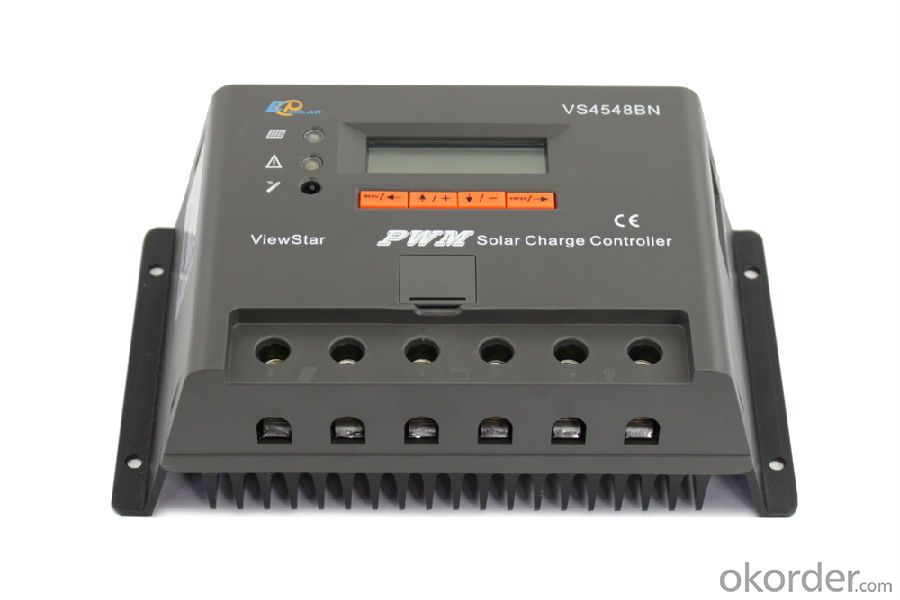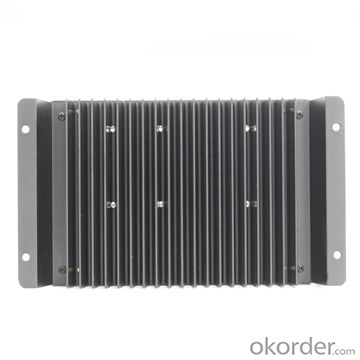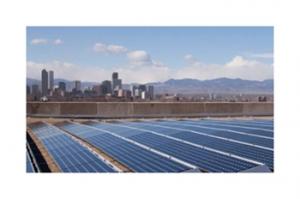North Bay Solar Charge Controllers LCD Display PWM Solar Panel Charge Controller/Regulator 45A 12/24/36/48V, VS4548BN
OKorder Service Pledge
OKorder Financial Service
You Might Also Like
ViewStar series solar controller is our new generation controller for off-grid solar system, such as street light, solar home system or small power station etc.
Features:
·Excellent EMC design
·32 bit MCU with high speed
·High efficient Series PWM charging
·Four battery type options: Sealed, Gel, Flooded, and USER
·Intelligent lighting and timer control for solar lighting system
·12 bit A/D high-precision sampling to ensure accuracy
·Use MOSFET as electronic switch
·Full control parameters setting and modification, diversified load control mode
·Humanized design of browser interface, undertake every operating conveniently
·Temperature compensation
·Adopt graphics dot-matrix LCD screen and HMI (human-machine interface) with 4 buttons,integrated menu displaying and operation
·Energy statistics function
·RS485 ports with MODBUS communication protocol
·Optional PC monitoring software and remote meter for real-time monitoring and battery management parameter setting
·Field upgradable firmware
Electronic Protections:
·PV short circuit protection
·PV reverse polarity protection
·Battery overcharge protection
·Battery over discharge protection
·Battery reverse polarity protection
·Load overload protection
·Load short circuit protection
·Overheating protection
Specification:
Nominal system voltage | 12/24/36/48V auto work | |||
Rated battery current | 20A | 30A | 45A | 60A |
Rated load current | 20A | 30A | 45A | 60A |
Max. battery voltage | 64V | |||
Equalize charging voltage | Sealed: 14.6V, Flooded: 14.8V, User-defined: 9~17V | |||
Boost charging voltage | Gel: 14.2V, Sealed: 14.6V, Flooded: 14.8V, User-defined: 9~17V | |||
Float charging voltage | Gel /Sealed /Flooded: 13.8V, User-defined: 9~17V | |||
Low voltage reconnect voltage | Gel /Sealed /Flooded: 12.6V, User-defined: 9~17V | |||
Low voltage disconnect voltage | Gel /Sealed /Flooded: 11.1V, User-defined: 9~17V | |||
Self-consumption | ≤15mA(12V); ≤10mA(24V); ≤9mA(36V); ≤8mA(48V) | |||
Grounding | Common negative | |||
Temp. compensation | -3mV/°C/2V | |||
Relative humidity | 10%~90% Non-condensation | |||
Communication | RS485 / RJ45 interface | |||
LCD temperature | -20°C ~ +70°C | |||
Working temperature | -25°C ~ +55°C | |||
Humidity | ≤95% N.C. | |||
Enclosure | IP30 | |||
Overall dimension | 200x103x58mm | 201x109x59mm | 205x119x67mm | 205x174x64mm |
Terminals | 16mm2 | 35mm2 | 35mm2 | 35mm2 |
Net weight | 0.7kg | 0.9kg | 1.2kg | 1.5kg |




FAQ:
Q1. What is the voltage?
A1. Our 45/60A solar charge controller is 12/24/36/48V auto work.
Q2. What is the difference between MPPT&PWM?
A2. MPPT has higher efficiency, it can track the max power point and won't waste energy.
Q3. What is the efficiency of the MPPT controller?
A3. MPPT>99%, peak conversion efficiency>98%.
Q4. What is the waranty of product?
A4. 12 months.
- Q: What is the maximum cable length between solar panels and a solar controller?
- The maximum cable length between solar panels and a solar controller can vary depending on several factors such as the type and gauge of the cable used, the voltage and current capacity of the solar panels, and the specific requirements of the solar controller. Generally, it is recommended to keep the cable length below 100 feet (30 meters) to minimize voltage drop and ensure efficient power transfer. However, it is important to consult the manufacturer's guidelines or seek professional advice to determine the maximum cable length suitable for your specific setup.
- Q: What is the maximum efficiency rating of a solar controller?
- The maximum efficiency rating of a solar controller can vary depending on the specific model and manufacturer. However, high-quality solar controllers typically have efficiency ratings ranging from 95% to 99%.
- Q: How long do solar controllers typically last?
- Solar controllers typically last between 5 to 15 years, depending on the quality of the controller and the environmental conditions it is subjected to.
- Q: How do I connect a solar controller to my solar panels?
- To connect a solar controller to your solar panels, follow these steps: 1. Identify the positive and negative terminals on your solar panels. 2. Connect the positive wire from the solar panels to the positive terminal on the solar controller. 3. Connect the negative wire from the solar panels to the negative terminal on the solar controller. 4. Ensure that the connections are secure and tight. 5. Connect the battery terminals to the corresponding positive and negative terminals on the solar controller. 6. Finally, connect the load terminals on the solar controller to the device or system you wish to power using solar energy. Remember to consult the specific instructions provided by the manufacturer of your solar controller for accurate and safe installation.
- Q: Can a solar controller be used with a solar-powered signage system?
- Yes, a solar controller can be used with a solar-powered signage system. A solar controller regulates the voltage and current flow from the solar panels to the signage system, ensuring proper charging and optimal performance of the system.
- Q: What is the role of a solar controller in preventing battery sulfation?
- The role of a solar controller in preventing battery sulfation is to regulate the charging process of the battery and ensure that it is done efficiently and effectively. By monitoring the battery voltage and current, the solar controller can prevent overcharging, which is a major cause of battery sulfation. It also controls the charging rate to avoid undercharging, which can lead to sulfation as well. Overall, the solar controller plays a crucial role in maintaining the optimal charging conditions for the battery, thereby preventing sulfation and prolonging its lifespan.
- Q: Can a solar controller be used with a solar-powered marine navigation system?
- Yes, a solar controller can be used with a solar-powered marine navigation system. A solar controller, also known as a charge controller, is an essential component of a solar power system. It regulates the flow of electricity from the solar panels to the battery bank, ensuring optimal charging and preventing overcharging or damage to the batteries. In the case of a solar-powered marine navigation system, the solar controller plays a crucial role in managing the energy generated by the solar panels. It ensures that the batteries are charged efficiently and protects them from overcharging, which can lead to reduced battery life or even failure. By using a solar controller, the solar-powered marine navigation system can harness the energy from the sun and convert it into usable power for the navigation equipment. This allows for reliable and sustainable operation of the system, even in remote or off-grid locations where traditional power sources may be limited or unavailable. Therefore, a solar controller is not only compatible but also necessary for the proper functioning and longevity of a solar-powered marine navigation system.
- Q: Can a solar controller be used in a grid-tied solar power system?
- Indeed, a solar controller has the potential to be utilized within a grid-tied solar power system. However, it is imperative to acknowledge that the primary function of a solar controller lies in regulating the charging and discharging of batteries within an off-grid solar system. In the case of a grid-tied system, the solar panels are directly connected to the utility grid, rendering battery storage unnecessary. Within a grid-tied solar power system, the role of the solar controller is confined to monitoring the performance of the solar panels and ensuring efficient electricity production. The controller may also offer data logging and monitoring capabilities, enabling the system owner to monitor energy production and consumption. Although a solar controller is not a crucial component in a grid-tied system, it can still prove advantageous for the purposes of system monitoring and maintenance. It provides valuable insights into the system's performance and aids in troubleshooting any potential issues that may arise. Moreover, certain solar controllers offer advanced features like MPPT (Maximum Power Point Tracking) technology, which optimizes the energy output of the solar panels, even within a grid-tied system. All things considered, while not essential, a solar controller can still be utilized within a grid-tied solar power system to elevate monitoring and optimization capabilities.
- Q: Can a solar controller be used in a solar-powered security system?
- Yes, a solar controller can be used in a solar-powered security system. Solar controllers are essential components in solar systems as they regulate the flow of energy from the solar panels to the batteries, ensuring efficient charging and preventing overcharging. In a solar-powered security system, the solar controller would play a crucial role in managing the power supply to the security devices, such as cameras and sensors, ensuring they have a reliable source of energy.
- Q: Can a solar controller be used with solar panels that are connected to a power inverter?
- Yes, a solar controller can be used with solar panels that are connected to a power inverter. In fact, it is recommended to use a solar controller in such setups to ensure proper charging and protection of the batteries connected to the power inverter. The solar controller regulates the voltage and current from the solar panels to the batteries, preventing overcharging and over-discharging. It also helps optimize the charging process, increasing the overall efficiency of the solar power system. Therefore, using a solar controller in conjunction with a power inverter is a good practice to maximize the performance and lifespan of the system.
Send your message to us
North Bay Solar Charge Controllers LCD Display PWM Solar Panel Charge Controller/Regulator 45A 12/24/36/48V, VS4548BN
OKorder Service Pledge
OKorder Financial Service
Similar products
Hot products
Hot Searches
Related keywords





























